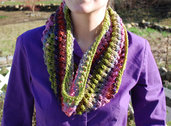The calendula I planted from seed awhile back is really starting to put out some flowers now. Yeah! I wait all year for those flowers. I gather them and dry them to use throughout the year. They are yet another herb that can really self-sow but I don’t mind a bit. They are very much welcome in my garden. Not only are they useful but they are also so cheerful. Their orange and yellow flowers really pop. Below is a picture of some “popping” out of my catmint (which is a monster right now!).

To Dry Calendula flowers
 My method for drying calendula flowers is the same method I use for drying most of my herbs. I place them on a paper towel lined cookie sheet and then cover with another piece of paper towel. They are then placed in the oven with the oven light left on. The oven light supplies enough heat to dry the flowers nicely. Just don’t forget you have them in there and accidently turn the oven on!
My method for drying calendula flowers is the same method I use for drying most of my herbs. I place them on a paper towel lined cookie sheet and then cover with another piece of paper towel. They are then placed in the oven with the oven light left on. The oven light supplies enough heat to dry the flowers nicely. Just don’t forget you have them in there and accidently turn the oven on!
There are so many things you can do with the calendula flowers. The petals can be used fresh or dried in cooking (be sure to remove the bitter center before adding to a dish). The dried petals can also add a bright splash of color to a bowl of potpourri. My absolute favorite item to make out of calendula flowers is an all purpose salve. It is fairly simple to make and is great for all kinds of skin ailments. I especially like it for a diaper rash treatment. It is also good on eczema. Plus it is really nice to put on your hands after a lot of time spent in the garden.
Recipe for Calendula Salve
Begin by placing some dried calendula flowers in a glass canning jar. Then fill the jar with olive oil or even almond oil. You want to make sure you completely cover the flowers. Place some plastic wrap over the top of the jar and then screw on the ring over the plastic wrap. Place the jar in a warm area out of direct sunlight. Leave the oil to infuse for one to three weeks. (Alternatively you could place the flowers and oil in a crock pot and gently warm for several hours.)
Once the oil is done infusing strain well and measure how much you have. Now place the oil in a double boiler and add ¼ cup (2 ounces) grated beeswax to every 1 cup (8 ounces) of oil. Gently warm the oil until all the beeswax has melted. Remove from the heat and pour into some sterilized containers. Once it cools it will become solid.
Use this salve on any type of skin irritation.
In the picture below I have a mix of calendula, chamomile, comfrey, and lavender infusing. I have been making this for so long now that I don’t bother to measure the herbs I use. I just add what I think looks good!













{ 13 comments… read them below or add one }
Thank you so much for the salve recipe; I’ve tucked that away for future use. I adore orange and yellows in combination with blues in the garden — the calendulas are beautiful! My Dad used to grow them every year.
Great post Cindy. I’m a big fan of calendulas and marigolds as well. They have such a cheery disposition in the garden that keeping them out would almost be a sin.
Nancy- You’re very welcome! The combo of the calendula and catmint was a complete accident- but I’m very pleased with the results!
The combo of the calendula and catmint was a complete accident- but I’m very pleased with the results!
Stuart- Thank you for the compliment! I have been growing calendula for years; the garden wouldn’t be the same without them.
Hey Cindy,
Your website has inspired me to try to create a calendula salve…I wonder, however, since my calendula is blooming one at a time (I kid you not), should I wait to soak the flower heads in oil or should I just keep throwing the dried heads in the oil as they appear?
Also, what does lavender look like when it’s ready to be harvested?
Thank you so much in advance,
Helen in Ithaca
Helen- This is what I do: I gather the flower heads as they appear and dry them, even if that means I am only drying a couple at a time. Once they are dry I place them in a jar like is shown in my post on chamomile and store them away from light and heat. When I have dried a decent amount I then place them in a glass jar and top with oil. I would recommend holding off on making the salve until you have enough dried flowers as the oil could turn rancid if it sits too long. However, herbs can infuse for up to six weeks in oil and still be fine. I personally do not like to push it that long and only infuse the oil for up to about three weeks.
To answer your question about lavender- I have some lavender that is ready to harvest so this week I will post some pictures and info on it!
I came back here after reading the post about the borage. I’m with you on that one. The borage flowers are beautiful, but I too am sensitive to anything with prickly stems and leaves. I just grow it anyway and scratch. I’m going to try your salve recipe. Maybe this will help me next year.
Jane Marie- I like borage too much to not have it in the garden even though it does not seem to like me! If you try the salve I am sure you will like it it smells so nice too!
Lovely! I’ve been patiently waiting for my herbs (calendula, comfrey and lavender) to steep for two weeks. Today’s the day! I’ve blended the oils and the little jars are cooling on my window sill as I type. I did add a few drops of eucalyptus oil and rosemary oils to the mix as well.
I’ve got Lavender Body Butter cooling and waiting to be whipped up and poured into its jars. My lip balm tubes are all lined up as well waiting to be filled!
I love days like this and my home smells so good!
My calendula oil is strained, the jars sterilized and today is the day to melt the beeswax in the oil and make the salve. A friend gave me her extra calendula plants and they are the high in resin kind, very sticky. I expect great thigs from the salve. Thanks
Peggy in Homer, Alaska
Can’t wait to try this; I have mild eczema and like to try out anything new, especially if it’s natural. Thank you!
Hello to show u how new I am at all this it took me a while to figure out that Calendula is Marigolds but none of the seeds that I find looks anything like yours…. is there a special species that you have to use for the healing componates? Any comments on this would greatly help
but none of the seeds that I find looks anything like yours…. is there a special species that you have to use for the healing componates? Any comments on this would greatly help
Hi Bridget! Thanks for your comment and thank you for reading my blog.
Sometimes there is confusion with Calendula because one of its common names is Pot Marigold. You might be having a hard time finding seeds because of this. Calendula’s botanical name is Calendula officinalis. Then there is the typical common annual garden flower marigold that is in the Tagetes family. These are sometimes confused with Calendula due to them sharing names but they are entirely different plants.
You can find seed to the Calendula I grow here. Hope this helps!
Thanks a million. With three children between the ages of 1 and 5 and being a Pastor’s family I am always looking for more that I can do naturally for my family and have had your page for this salve bookmarked all winter just waiting for the warmer weather so I could start growing some of the things I need.
{ 1 trackback }